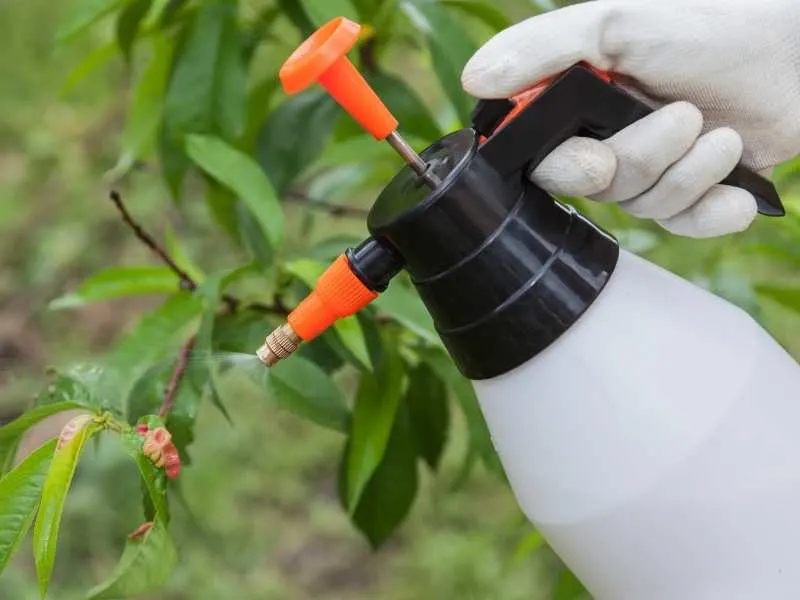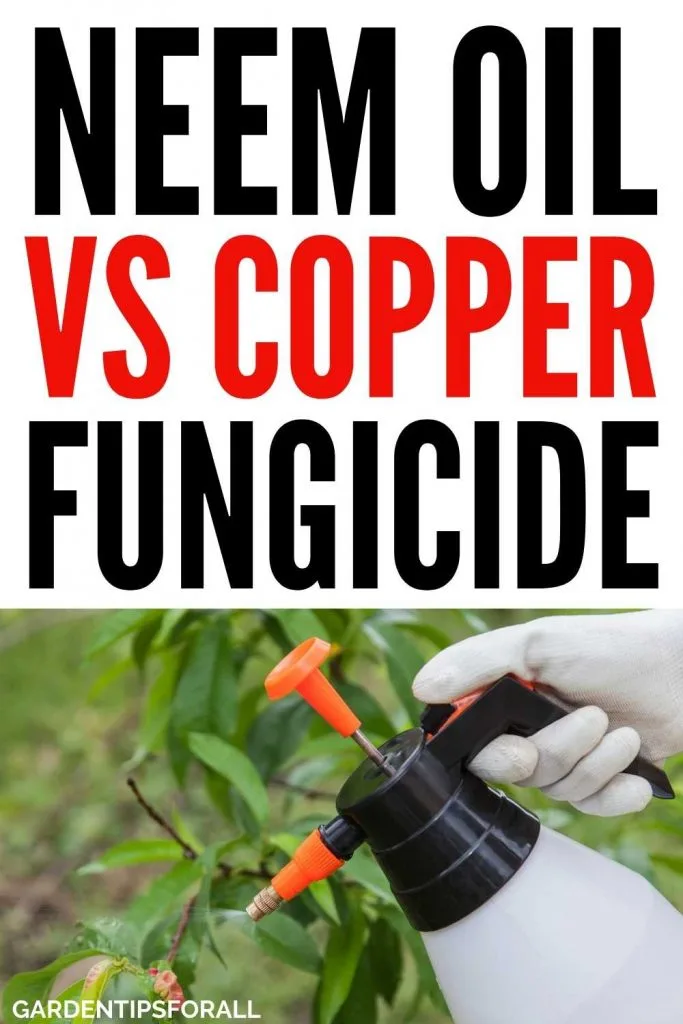Copper Fungicide vs. Neem Oil – Which is Better?
When dealing with pests and fungus, some farmers want to use organic products since they are safer and environmentally friendly. However, others will use any product as long as it’s effective. Regardless of the category you’re in, organic pesticides are a viable option since they are as effective as chemical products, sometimes even more effective.

Some of the most commonly used organic fungicides include copper fungicide and Neem oil. So which one is better?
Neem oil is often a better option since it kills both insects and fungus, and it can also help prevent fungal diseases. On the other hand, copper fungicide inhibits fungal diseases and kills most of the fungus, but it’s more effective as a preventative measure.
Neem oil is also biodegradable and will not leave residues in the soil. Copper is non-biodegradable, and will start contaminating the soil after some time.
In this article, I will discuss both of them, how they work, and when it’s best to use them.
(You may also want to read this article on copper vs sulfur fungicide).
What is Copper Fungicide?
Copper fungicide is made when the copper metal dissolves in water or when it’s combined with other compounds.
One of the most common copper fungicides is copper sulfate, which is made when the copper reacts with sulfuric acid. It kills pathogens through denaturation, where it alters the enzymes and other proteins’ natural qualities.
Bonide 811 Copper 4E Fungicide 16oz (473ML)
You apply the copper fungicide by spraying it on plant leaves, and once the leaves get wet, copper ions penetrate the leaves. These ions are the ones that work on the pathogens.
Some of the fungi that copper fungicide helps prevent and treat include:
- Fire Blight
- Anthracnose
- Black spot
- Septorial leafspot
- Downey Mildew
- Powdery Mildew
Copper Fungicide as a Fertilizer
Copper sulfate is also useful as a fertilizer. If your soil is copper-deficient, copper sulfate can help deal with the situation. Plants grown in copper-deficient soils show stunted growth, wilting, lower fruit production, and have fewer flowers. Be sure to test the soil to know the nutrients it lacks before applying copper sulfate.
You may also want to read this article to find out if cow manure is good for tomatoes.
Is Copper Fungicide Safe?
Excess copper fungicide could kill the plants. The ions could penetrate through stomates or parts of the leaves that have thin cuticles.
The leaves have to be wet for copper ions to be active. But if they’re wet for a long time, this may cause injuries to the plants.
If you use a surfactant (the compounds that help the fungicide spread on the leaf) you can also increase the chances of injuring your plants.
Besides being toxic, excess copper may affect the fruits. Copper improves the flavor, conductivity, and water accumulation of the fruits. However, if it’s too much, the fruits may be watery, and may not have the required flavor.
Copper also doesn’t break down. Eventually, it will accumulate in the soil, and it may wash into nearby streams. High amounts of copper are toxic to soil bacteria and organisms such as earthworms.
If you have a small garden, you may not dump enough copper to amount to toxic levels, but it’s worth considering when comparing it with other organic fungicides.
Did you know that you can also use hydrogen peroxide as a fungicide? Find out how much hydrogen peroxide for plants to use.
When Should You Apply Copper Fungicide?
Copper fungicide is more effective at preventing fungal diseases rather than curing them. But it’s still effective in killing most fungi, except late blight in tomatoes and potatoes.
So it’s best applied before you notice any signs of the diseases or when you first see the symptoms.
When used in the right amounts, you can apply it every 7 to 10 days until harvest.
Make sure you’ll have at least 12 hours of dry weather after application. This will give the copper fungicide enough time to dry.
Just like most pesticides, copper fungicide is best applied when it’s cool, preferably early in the morning or late in the evening. This is to ensure you don’t apply it when beneficial animals like bees and butterflies are active.
When dealing with very young plants, use a diluted mixture to minimize the harmful effects.
Copper fungicides should be applied sparingly and by strictly following the manufacturer’s instructions. Since there are several formulas available, the mixing ratios may differ.
What is Neem Oil?
Neem oil is a by-product the Azadirachta Indica tree. It contains Azadirachtin, a natural insecticide that effectively kills and repels a wide range of insects. The roots take up neem oil into the plant’s system. Once it’s in the system, the insects feed on it. It acts by inhibiting their growth, killing them, or preventing them from feeding on the plants.
Organic Neem Bliss 100% Pure Cold Pressed Neem Seed Oil – (16 oz)
Like copper fungicide, Neem oil also prevents fungal disease and kills fungi as well including:
- Late blight
- Root rot
- Tip Blight
- Anthracnose
- Powdery mildew
- Rust
- Fire Blight
Related: Benefits of Neem Oil for Tomatoes and Other Plants
Neem Oil as a Fertilizer
Neem oil also makes a good fertilizer. One of the main benefits it has is controlling the nitrification of other chemical fertilizers. Unlike copper fungicide, it’s a more balanced fertilizer since it has the main components of fertilizers (Nitrogen, Phosphorous, and potassium).
It also provides food for earthworms and other soil-based organisms that facilitate soil aeration and add to the soil’s organic matter. It also helps kill nematodes in the soil.
Is Neem Oil Safe?
Neem oil is safe for most plants, including vegetables, but to be on the safer side, test on a few plants before spraying the whole crops. Unlike copper fungicide, Neem oil breaks down eventually, and it doesn’t harm any soil organisms.
As mentioned earlier, Neem fertilizer is suitable for soil-based microorganisms.
You can use Neem oil up to the harvesting day, but make sure you wash the edible plants very well before consumption.
If undiluted Neem oil comes in contact with your skin, it may cause skin rashes.
When ingested, it may cause some allergic reactions and other health issues. But it is perfectly safe to be sprayed on plants.
You may also want to read this article to find out if you can eat vegetables sprayed with neem oil.
When Should You Apply Neem Oil?
Neem oil can be applied throughout the plant’s growth period. Since it has anti-fungal qualities, it can kill or prevent the fungus from affecting your plants. It may not be harmful to beneficial animals like bees, but don’t spray when they are active.
Copper Fungicide vs Neem Oil Compared – Conclusion
According to most users and scientific studies, both Neem oil and copper fungicide are effective in dealing with fungal diseases and amending the soils. Although, they work differently.
Neem oil is biodegradable, while copper fungicide is non-biodegradable and leads to copper accumulation in the soil. That being said, both have their risks. For instance, they may burn the foliage when used under high temperatures. They may also be toxic to humans if ingested.
So it all comes down to the soil deficiencies you’re dealing with when choosing between one of these two options. You should also handle them with care and follow the instructions to minimize the adverse effects.

References


